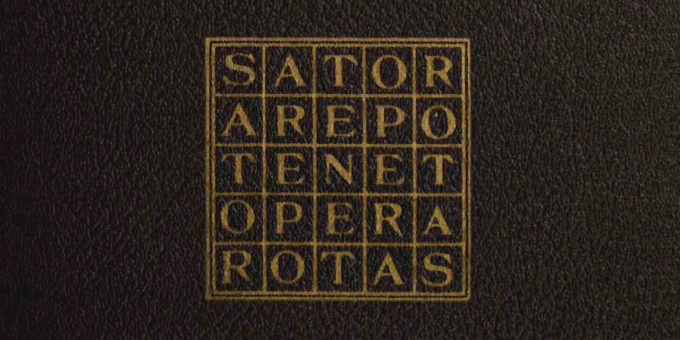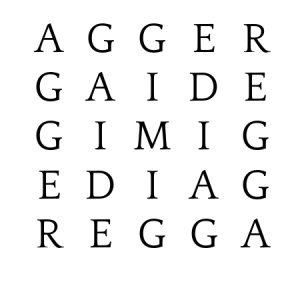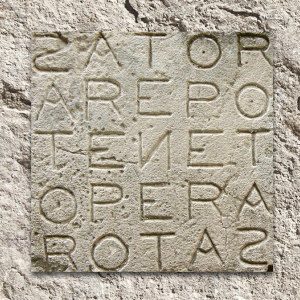
Ancient magick is supposed to be discovered in forbidden vaults of sinister occult lodges, musty darkness of monastery dungeons, or at least in closely guarded private collections of manuscripts. This one was found in a dumpster.
It was first disclosed, although went mostly unnoticed, more than a decade ago by an anonymous Russian occultist, and like every respectable occult magick, it comes with a story. According to him, the material was reconstructed from handwritten notes on the margins in a pre-revolutionary edition of Papus (which makes this magick at least a hundred years old), a poor samizdat-era photocopy of which found its way to him in an unexpected and somewhat comical manner – in a pile of discarded old books and papers somebody left by a trash container.
Not all of the writing could be deciphered, but the general meaning was clear. Except for who made it and when. According to the notes, a complete, tried and proven system was presented, it was even laid over the relevant parts of the Papus text in such a manner as if to demonstrate its superiority. This story may be true or fictitious, it does not matter. The magickal technology is real and it works.
A set of about a dozen Latin Square talismans had been tested over a period of slightly less than a year, and was found to bring consistent and repeatable good results for a broad range of goals, from manipulating circumstances to altering beliefs and personality traits. And notably, neutral character combined with stunning simplicity and zero need for maintenance make it an ideal supporting magick for a more direct and active system, such as based on Goetia or Shem work.
But don’t regard it as secondary – the Magick of Latin Squares is perfectly usable on its own, producing gentle, but definite and timely outcomes. One of the talismans was actually posted here before, though with a different method of charging and without mentioning that it belonged to a bigger structure, because of the experiments still ongoing.
Now, with the introductory part out of the way, let us get to business. The pages you are going to read contain, to my knowledge, the only complete and usable exposition of this forgotten magick in a language other than Russian.
Please keep in mind that other than having a similar name, magickal Latin Squares have nothing to do with the type of matrices called Latin Squares which are studied in combinatorics and linear algebra, and constitute a totally different thing, although they may sometimes bear visual resemblance.
 This is a Latin Square. It looks like nothing complex, and even if it doesn’t presently make any sense, by the end of these pages you will possess a thorough understanding of how to compose, craft, activate, use and deactivate such Squares for any conceivable purpose.
This is a Latin Square. It looks like nothing complex, and even if it doesn’t presently make any sense, by the end of these pages you will possess a thorough understanding of how to compose, craft, activate, use and deactivate such Squares for any conceivable purpose.
Traditionally the Squares have been depicted in the following two ways: The Square on the left has a frame, one on the right doesn’t. There’s no difference, and both variants are equivalent. There can be any kind of frame, its function is purely decorative.
The Square on the left has a frame, one on the right doesn’t. There’s no difference, and both variants are equivalent. There can be any kind of frame, its function is purely decorative.
Now for the important part. There can be only one type of Latin Square: five by five letters. Any other number is impossible. Only letters of the Latin alphabet, derived from the Keyword and Motto which define the Square. Any other version is inadmissible. Only Latin, plain and simple!
Latin is not only the extinct language of legendary caesars, philosophers and poets of the ancient Roman Empire. For thousands of years it had been the language of those who carried the fire of knowledge through the dark mists of ignorance – theologians, philosophers, doctors, lawyers, and of course, alchemists and sorcerers. And to this day the Latin language is virtually synonymous with magick itself, at least in the Western world.
Here is the famous SATOR magick square as known for more than 2000 years.
It became the prototype of the Latin Magick Squares presented here by providing the general structure of the talismans. This is a confirmed fact, since both Squares, SATOR and MAGUS, were depicted side by side in the original handwritten source material. Hence the 5×5 size of the grid and the pattern of letter placement.
Let’s examine the already mentioned Square as an example. First of all, the Keyword and Motto must be chosen that represent the intended result of the operation. In this example the desired goal is military success, so the keyword is BELLO – “to wage war”. The quote “Audentes fortuna juvat” (A.F.J.), meaning “Fortune favors the brave”, is used as the motto. Initial letters of the motto must not be the same.
A Square is composed in the following manner. First the keyword is written – BELLO. Then the outer sides of the square are formed in the given order:
Next the inner square is formed, composed from the initial letters of the motto – A.F.J. The sequence is identical for both the outer and inner squares. The inner square is written into the already constructed outer square.
The end result should look like the following figure: 
The center of the Square isn’t filled by a letter. And here is a very important point. Every Square is active for a duration of time strictly defined by its creator. It is specified by writing the desired number of days as a single Roman numeral in the center of the Square. Just one letter, out of seven possible:
I (1) X (10) C (100) M (1000) V (5) L (50) D (500)
This is the complete Latin Square. Every Square has a name which is the same as its keyword. A finished BELLO Square that will work for 10 (X) days: Keeping good records is vital for occult practice of any kind, and this system is no exception. The best way would be to take a separate notebook or computer file and use it exclusively for the magick of Latin Squares. Write down the rules and order of construction and pre-made squares. Draw your own Squares on separate pages, one per page, taking notes of the purpose, keyword, motto, activation and expiration dates.
Keeping good records is vital for occult practice of any kind, and this system is no exception. The best way would be to take a separate notebook or computer file and use it exclusively for the magick of Latin Squares. Write down the rules and order of construction and pre-made squares. Draw your own Squares on separate pages, one per page, taking notes of the purpose, keyword, motto, activation and expiration dates.
On the first page of such notebook a special ILLAC Square without a date should be drawn. ILLAC – “along that way”. “Fiat voluntas tua” (F.V.T.) – “Your will be done”.
Congratulations, you are now capable of constructing the Latin Squares all by yourself. You don’t even need to know the language in order to do it, provided you have a Latin dictionary and a phrasebook (or Google) at your disposal.
Now let us look into the task of how to do it properly, which is going to be the subject of the next part.




